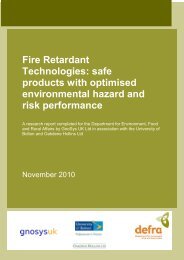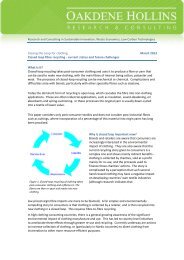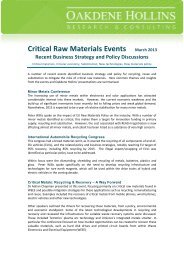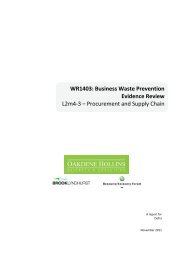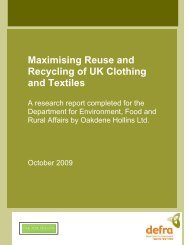Recycling of Low Grade Clothing Waste - Oakdene Hollins
Recycling of Low Grade Clothing Waste - Oakdene Hollins
Recycling of Low Grade Clothing Waste - Oakdene Hollins
Create successful ePaper yourself
Turn your PDF publications into a flip-book with our unique Google optimized e-Paper software.
© <strong>Oakdene</strong> <strong>Hollins</strong> Ltd, Salvation Army Trading Company Ltd<br />
Nonwovens Innovation & Research Institute Ltd September 2006<br />
costs last year and that this figure had increased by £60k (14%) since the<br />
previous year. An appeal was made to both over‐generous, but misguided,<br />
donors and to the ‘fly tippers’ who leave unsuitable bags <strong>of</strong> textiles on<br />
charity shop doorsteps out <strong>of</strong> trading hours. This is not a message which<br />
charities would want to broadcast regularly, since any suggestion that the<br />
industry does not welcome donations would discourage donors <strong>of</strong> quality<br />
items as well.<br />
5.3.3 Merchants<br />
Estimates <strong>of</strong> the trend in the main costs experienced by the merchants are<br />
set out in the Table 11.<br />
Table 11: Operating Cost Trends<br />
Operating costs, per tonne 1990 2005 % Increase<br />
Collection from nationwide bank £110 £155 41%<br />
Collection from local bank £80 £115 44%<br />
Door-to-door collection nationwide £250 £300 20%<br />
Door-to-door collection local £210 £260 24%<br />
Sorting into 140 grades £80 to £105 £150 to £200 90%<br />
Notes: 1. Door-to-door costs include the cost <strong>of</strong> bags and literature.<br />
2. 1990 sorting costs estimated from 2005 costs using ONS earnings indices and<br />
estimates <strong>of</strong> landfill cost escalation.<br />
None <strong>of</strong> the above costs include contributions to a charity or council<br />
No historical data are available for sorting costs, but as for the charities, key<br />
elements <strong>of</strong> these will be employment and disposal costs, both <strong>of</strong> which<br />
have also risen in real terms in recent years. From earnings indices and<br />
from landfill cost changes it has been possible to calculate likely sorting<br />
costs for 1990.<br />
When compared to inflation <strong>of</strong> c.52%, as measured by the RPI, collection<br />
costs appear to be reducing in real terms. Given above inflation increases in<br />
fuel and employment costs, this is thought to have occurred largely as a<br />
result <strong>of</strong> the efficiencies <strong>of</strong> scale that have occurred over the period.<br />
The 2005 RRE‐USE report suggested that, across Europe, sorting costs have<br />
increased by 25% in five years and, except in Poland, the number <strong>of</strong><br />
recycling enterprises has been declining by 10% to 20% per year.<br />
For Defra Page 43



